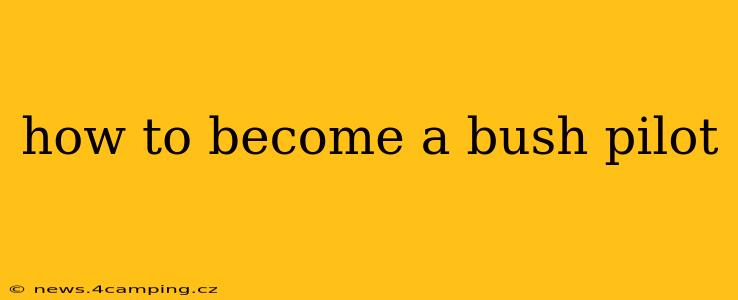The romantic image of a bush pilot, soaring over rugged terrain and landing on makeshift airstrips, captivates many. But the reality of becoming a bush pilot involves rigorous training, dedication, and a deep understanding of challenging flying conditions. This comprehensive guide outlines the path to achieving this challenging yet rewarding career.
What Does it Take to Become a Bush Pilot?
Becoming a bush pilot requires more than just a pilot's license. It demands a unique blend of skills, including exceptional piloting abilities, meticulous planning, resourcefulness, and the ability to handle unpredictable situations. You'll need strong decision-making skills under pressure, excellent spatial awareness, and the physical and mental stamina to cope with demanding flight conditions.
What are the Steps to Becoming a Bush Pilot?
The journey to becoming a bush pilot is multifaceted, involving several key steps:
1. Obtain a Private Pilot License (PPL):
This is the foundational step. You'll learn the basics of flight, aircraft control, navigation, meteorology, and regulations. Expect rigorous ground school and flight training, culminating in a practical exam.
2. Obtain a Commercial Pilot License (CPL):
After your PPL, you'll need a CPL, which allows you to fly for compensation or hire. This involves more advanced training in instrument flight, multi-engine aircraft operation, and night flying.
3. Obtain an Instrument Rating (IR):
This rating is crucial for bush flying, enabling you to navigate and fly in instrument meteorological conditions (IMC), often encountered in remote areas. This training focuses on flying solely by instruments, crucial for navigating low visibility and challenging weather patterns.
4. Gain Experience:
This is arguably the most important stage. Accumulating significant flight hours is vital, particularly in challenging environments. Seek opportunities to gain experience in varied conditions and aircraft types, building up your skills and confidence. Look for opportunities with flight schools or smaller airlines that operate in less-demanding environments before moving to bush flying.
5. Specialized Training for Bush Flying:
While not always mandatory, specialized bush flying training is highly recommended. This training focuses on short takeoff and landing (STOL) techniques, operating in challenging terrain, survival skills, and emergency procedures specific to remote areas. Look for reputable flight schools that offer such courses.
6. Obtain Necessary Ratings and Endorsements:
Depending on the region and type of flying, additional ratings and endorsements might be required. These could include a seaplane rating, mountain flying endorsement, or specialized equipment ratings. Check with the relevant aviation authorities in your target region.
What are the Different Types of Bush Flying?
Bush flying encompasses a wide range of activities:
- Cargo and passenger transport: This involves delivering essential goods and people to remote communities.
- Aerial surveys and photography: Bush pilots often assist in geological surveys, environmental monitoring, and aerial photography.
- Medical evacuations (MEDEVAC): This critical role involves transporting patients from remote locations to medical facilities.
- Firefighting: Bush pilots are often involved in aerial firefighting operations, dropping water or retardant on wildfires.
What are the challenges of being a bush pilot?
Bush flying presents unique challenges:
- Remote and challenging terrain: Navigating mountainous regions, dense forests, and unpredictable weather requires exceptional skills and judgment.
- Unpredictable weather: Rapidly changing weather conditions necessitate constant vigilance and adaptable flight planning.
- Unimproved airstrips: Landing and taking off from short, uneven, and sometimes unmaintained airstrips requires advanced piloting techniques.
- Isolation and remoteness: Bush pilots often work in isolated areas, requiring self-reliance and the ability to handle emergencies independently.
- Maintenance and repairs: Access to maintenance and repair facilities is often limited, requiring bush pilots to be skilled in basic aircraft maintenance and troubleshooting.
How much does it cost to become a bush pilot?
The cost of becoming a bush pilot varies significantly based on the country, the flight school, and the duration of training. Expect to invest a substantial amount of money in flight training, licensing, and specialized courses. Research thoroughly and compare different options before committing.
What are the job prospects for bush pilots?
Job prospects for bush pilots can be competitive, particularly in certain regions. However, the demand for skilled bush pilots remains steady, particularly in areas with limited infrastructure and challenging terrain. Networking, building a strong reputation, and acquiring relevant experience are crucial for securing employment in this field.
This comprehensive guide provides a roadmap to becoming a bush pilot. Remember that this is a demanding and challenging career, requiring dedication, skill, and a passion for flying in challenging environments. But the rewards—both personal and professional—are immeasurable for those who succeed.
